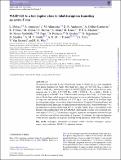WASP-121 b : a hot Jupiter close to tidal disruption transiting an active F star
Abstract
We present the discovery by the WASP-South survey of WASP-121 b, a new remarkable short-period transiting hot Jupiter. The planet has a mass of 1.183+0.064−0.062 MJup, a radius of 1.865 ± 0.044 RJup, and transits every 1.2749255+0.0000020−0.0000025 days an active F6-type main-sequence star (V = 10.4, 1.353+0.080−0.079 M⊙, 1.458 ± 0.030 R⊙, Teff = 6460 ± 140 K). A notable property of WASP-121 b is that its orbital semimajor axis is only ∼1.15 times larger than its Roche limit, which suggests that the planet is close to tidal disruption. Furthermore, its large size and extreme irradiation (∼7.1 109 erg s−1 cm−2) make it an excellent target for atmospheric studies via secondary eclipse observations. Using the TRAnsiting Planets and PlanetesImals Small Telescope, we indeed detect its emission in the z′-band at better than ∼4σ, the measured occultation depth being 603 ± 130 ppm. Finally, from a measurement of the Rossiter–McLaughlin effect with the CORALIE spectrograph, we infer a sky-projected spin-orbit angle of 257∘.8+5∘.3−5∘.5. This result may suggest a significant misalignment between the spin axis of the host star and the orbital plane of the planet. If confirmed, this high misalignment would favour a migration of the planet involving strong dynamical events with a third body.
Citation
Delrez , L , Santerne , A , Almenara , J-M , Anderson , D R , Cameron , A C , Díaz , R F , Gillon , M , Hellier , C , Jehin , E , Lendl , M , Maxted , P F L , Neveu-VanMalle , M , Pepe , F , Pollacco , D , Queloz , D , Ségransan , D , Smalley , B , Smith , A M S , Triaud , A H M J , Udry , S , Van Grootel , V & West , R G 2016 , ' WASP-121 b : a hot Jupiter close to tidal disruption transiting an active F star ' , Monthly Notices of the Royal Astronomical Society , vol. 458 , no. 4 , pp. 4025-4043 . https://doi.org/10.1093/mnras/stw522
Publication
Monthly Notices of the Royal Astronomical Society
Status
Peer reviewed
ISSN
0035-8711Type
Journal article
Description
Funding for WASP comes from consortium universities and from UK’s Science and Technology Facilities Council. TRAPPIST is a project funded by the Belgian Fund for Scientific Research (Fonds National de la Recherche Scientifique, F.R.S.-FNRS) under grant FRFC 2.5.594.09.F, with the participation of the Swiss National Science Fundation (SNF). The Swiss Euler Telescope is operated by the University of Geneva, and is funded by the Swiss National Science Foundation. LD acknowledges support of the F.R.I.A. fund of the FNRS. MG, EJ and VVG are FNRS Research Associates. ML acknowledges support of the European Research Council through the European Union‘s Seventh Framework Programme (FP7/2007-2013)/ERC grant agreement number 336480. AHMJT received funding from a fellowship provided by the Swiss National Science Foundation under grant number P300P2-147773.ASis supported by the European Union under a Marie Curie Intra-European Fellowship for Career Development with reference FP7-PEOPLE- 2013-IEF, number 627202.Collections
Items in the St Andrews Research Repository are protected by copyright, with all rights reserved, unless otherwise indicated.

